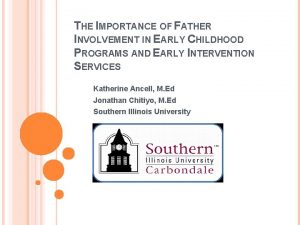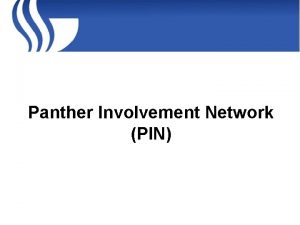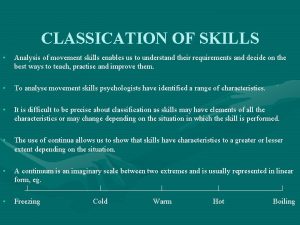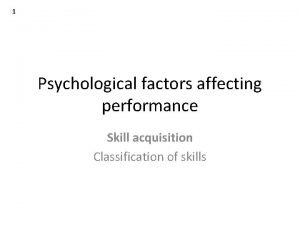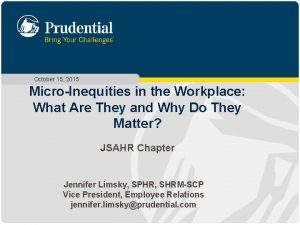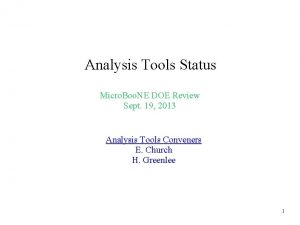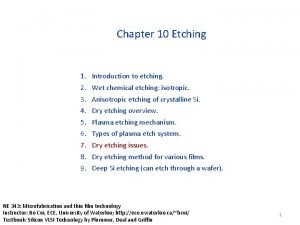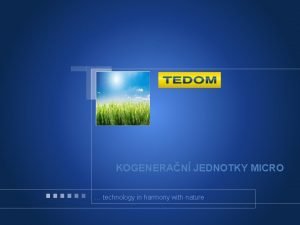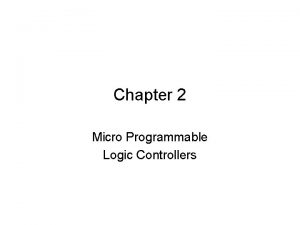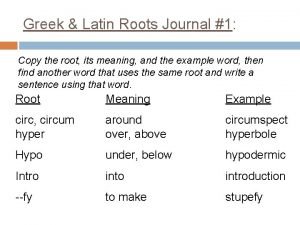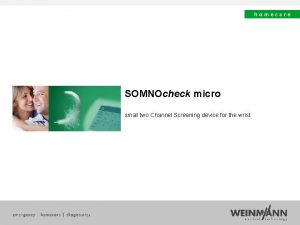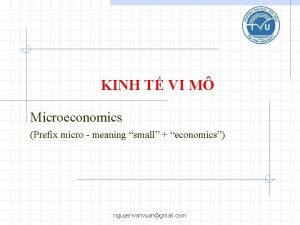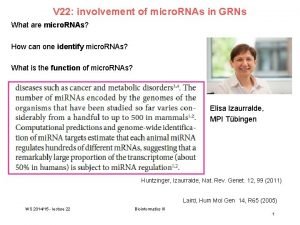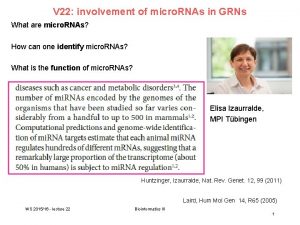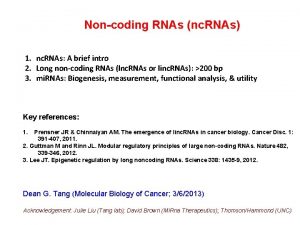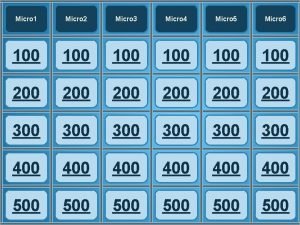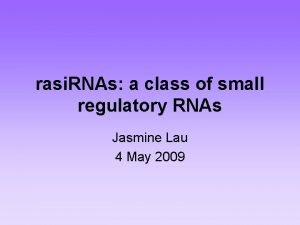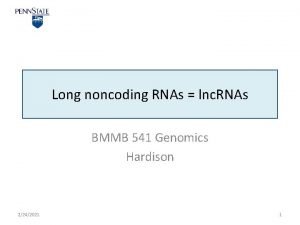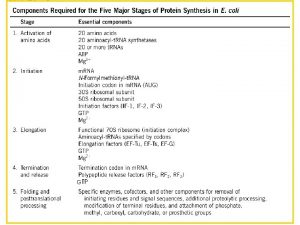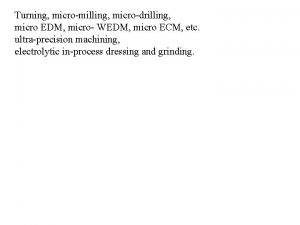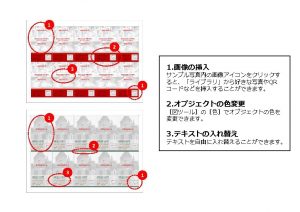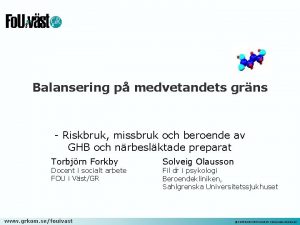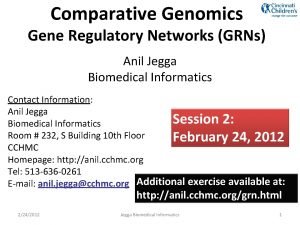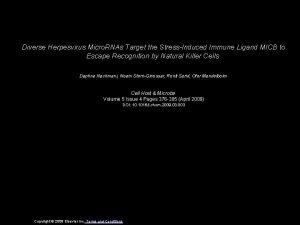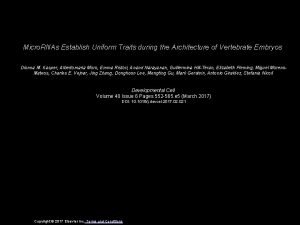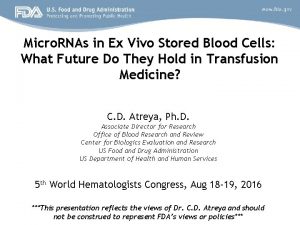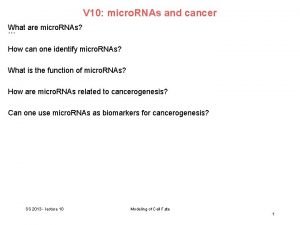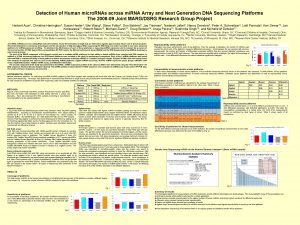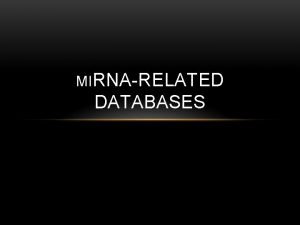V 16 involvement of micro RNAs in GRNs



















































- Slides: 51

V 16: involvement of micro. RNAs in GRNs What are micro. RNAs? How can one identify micro. RNAs? What is the function of micro. RNAs? Elisa Izaurralde, MPI Tübingen Huntzinger, Izaurralde, Nat. Rev. Genet. 12, 99 (2011) Laird, Hum Mol Gen 14, R 65 (2005) WS 2019/20 - lecture 16 Bioinformatics III 1

RNA world short name full name m. RNA, r. RNA, t. RNA, function you know them well. . . oligomerization Single-stranded sn. RNA sno. RNA small nuclear RNA small nucleolar RNA splicing and other functions nucleotide modification of RNAs Long nc. RNA Long noncoding RNA various mi. RNA micro. RNA gene regulation single-stranded si. RNA small interfering RNA gene regulation double-stranded WS 2019/20 - lecture 16 Bioinformatics III 2

RNA double-strand structure RNA, like DNA, can form double helices held together by the pairing of complementary bases, and such helices are ubiquitous in functional RNAs. In contrast to DNA, RNA forms an A-form helix with a radius of ∼ 1. 2 nm and a length increase per base pair of ∼ 2. 8 Å, ∼ 20% wider and shorter than B-form ds. DNA PNAS (2014) 111, 15408– 15413. WS 2019/20 - lecture 16 Bioinformatics III 3

RNA secondary structure Basic structural motifs of RNA secondary structure. This RNA consists of five stems (labeled S 1 -S 5) connected by loops (labeled according to loop type). WS 2019/20 - lecture 16 Bioinformatics III 4

Structure of single-stranded RNA Also single stranded RNA molecules frequently adopt a specific tertiary structure. The scaffold for this structure is provided by secondary structural elements which are non-covalent hydrogen bonds within the molecule. This leads to several recognizable structural "domain“ types of secondary structure such as hairpin loops, bulges and internal loops. RNA hairpin 2 RLU Stem loop 1 NZ 1 www. rcsb. org WS 2019/20 - lecture 16 Bioinformatics III 5

RNA tertiary structure 3 D structure of the VS ribozyme. This ribozyme (ribonucleic acid & enzyme) from the mitochondria of Neurospora performs self-cleavage during replication. Shown is the catalytic domain (helices 2– 6) of one protomer and the substrate-helix (helix 1) that belongs to another protomer. The three-way helical junctions 2 -3 -6 and 3 -4 -5 organize the overall fold of the catalytic domain. Suslov et al. Nature Chemical Biology 11, 840– 846 (2015). WS 2019/20 - lecture 16 Yellow spheres : scissile phosphate. Red sticks : catalytic nucleobases. Junction 1 -2 -7 and accompanying helices 1 and 7 have been omitted for clarity. Bioinformatics III 6

sn. RNAs Small nuclear RNA (sn. RNA) are found within the nucleus of eukaryotic cells. They are transcribed by RNA polymerase II or RNA polymerase III and are involved in a variety of important processes such as - RNA splicing, - regulation of transcription factors or RNA polymerase II, and - maintaining the telomeres. sn. RNAs are always associated with specific proteins. The sn. RNA: protein complexes are referred to as small nuclear ribonucleoproteins (sn. RNP) or sometimes as snurps. 5 small nuclear RNAs (sn. RNAs) and approximately 50 different proteins make up the splicing machinery. The five sn. RNAs are essential splicing factors. Each sn. RNA is associated with several different proteins to make up five sn. RNP complexes, called U 1, U 2, U 4, U 5 and U 6. WS 2019/20 - lecture 16 www. wikipedia. org Bioinformatics III 7

sno. RNAs A large subgroup of sn. RNAs are known as small nucleolar RNAs (sno. RNAs). These are small RNA molecules that play an essential role in RNA biogenesis and guide chemical modifications of r. RNAs, t. RNAs and sn. RNAs. They are located in the nucleolus and the cajal bodies of eukaryotic cells. Predicted structure of hybrids between novel sno. RNAs and target RNAs. Top: predicted sno. RNA Bottom: target small nuclear RNA (sn. RNA) Kishore et al. Genome Biology 2013 14: R 45 www. wikipedia. org WS 2019/20 - lecture 16 Bioinformatics III 8

RNA interference may involve si. RNAs or mi. RNAs. Nobel prize in Physiology or Medicine 2006 for their discovery of RNAi in C. elegans in 1998. Andrew Fire Craig Mello www. wikipedia. org WS 2019/20 - lecture 16 Bioinformatics III 9

si. RNAs Small interfering RNA (si. RNA), sometimes known as short interfering RNA or silencing RNA, is a class of - double-stranded RNA molecules, - that are 20 -25 nucleotides in length (often precisely 21 nt) and play a variety of roles in biology. Most notably, si. RNA is involved in the RNA interference (RNAi) pathway, where it interferes with the expression of a specific gene. In addition to their role in the RNAi pathway, si. RNAs also act in RNAi-related pathways, e. g. , as an antiviral mechanism or in shaping the chromatin structure of a genome. www. wikipedia. org WS 2019/20 - lecture 16 Bioinformatics III 10

mi. RNAs In contrast to double-stranded si. RNA, micro. RNAs (mi. RNA) are single-stranded RNA molecules of 21 -23 nucleotides in length. mi. RNAs have a crucial role in regulating gene expression. Remember: mi. RNAs are encoded by DNA but not translated into protein (non-coding RNA). www. wikipedia. org WS 2019/20 - lecture 16 Bioinformatics III 11

Overview of the mi. RNA network RNA polymerase II (Pol II) produces a 500– 3, 000 nucleotide transcript, called the primary micro. RNA (pri-mi. RNA). pri-mi. RNA is then cropped to form a pre-mi. RNA hairpin of ~60– 100 nucleotides in length by a multi-protein complex that includes the protein DROSHA. WS 2019/20 - lecture 16 Bioinformatics III AA, poly A tail; m 7 G, 7 -methylguanosine cap; ORF, open reading frame. Ryan et al. Nature Rev. Cancer (2010) 10, 389 12

Overview of the mi. RNA network This double-stranded premi. RNA hairpin structure is exported from the nucleus by RAN GTPase and exportin 5 (XPO 5). Finally, the pre-mi. RNA is cleaved by the protein DICER 1 to produce two mi. RNA strands: - a mature mi. RNA sequence, approximately 20 nt in length, - and its short-lived complementary sequence, which is denoted mi. R. WS 2019/20 - lecture 16 Bioinformatics III Ryan et al. Nature Rev. Cancer (2010) 10, 389 13

DROSHA X-ray structure The overall structure of DROSHA is surprisingly similar to that of Dicer despite no sequence homology apart from the C-terminal part. This suggests that DROSHA may have evolved from a Dicer homolog. AA, poly A tail; m 7 G, 7 -methylguanosine cap; ORF, open reading frame. WS 2019/20 - lecture 16 Bioinformatics III Kwon et al. Cell. (2016) 164: 81 -90. 14

Overview of the mi. RNA network The RISC complex is then targeted by the mi. RNA to the target 3′ untranslated region of a m. RNA sequence to facilitate repression and cleavage. The thermodynamic stability of the mi. RNA duplex termini and the identity of the nucleotides in the 3′ overhang determines which of the single strand mi. RNA is incorporated into the RNA-inducing silencing complex (RISC). The main function of mi. RNAs is to down-regulate gene expression of their target m. RNAs. WS 2019/20 - lecture 16 Bioinformatics III Ryan et al. Nature Rev. Cancer (2010) 10, 389 15

mi. RNAs Mature mi. RNA molecules are partially complementary to one or more m. RNA molecules. Fig. shows the solution NMR-structure of let-7 mi. RNA: lin-41 m. RNA complex from C. elegans Cevec et al. Nucl. Acids Res. (2008) 36: 2330. mi. RNAs typically have incomplete base pairing to a target and inhibit the translation of many different m. RNAs with similar sequences. In contrast, si. RNAs typically base-pair perfectly and induce m. RNA cleavage only in a single, specific target. www. wikipedia. org WS 2019/20 - lecture 16 Bioinformatics III 16

discovery of let 7 The first two known micro. RNAs, lin-4 and let-7, were originally discovered in the nematode C. elegans. There, they control the timing of stem-cell division and differentiation. let-7 was subsequently found as the first known human mi. RNA. let-7 and its family members are highly conserved across species in sequence and function. Misregulation of let-7 leads to a less differentiated cellular state and the development of cell-based diseases such as cancer. Pasquinelli et al. Nature (2000) 408, 86 www. wikipedia. org WS 2019/20 - lecture 16 Bioinformatics III 17

mi. RNA discovery approaches, both biological and bioinformatics, have now yielded many thousands of mi. RNAs. This process continues with new mi. RNA appearing daily in various databases. mi. RNA sequences and annotations are compiled in the online repository mi. RBase (http: //www. mirbase. org/). Each entry in the database represents a predicted hairpin portion of a mi. RNA transcript with information on the location and sequence of the mature mi. RNA sequence Liu et al. Brief Bioinf. (2012) doi: 10. 1093/bib/bbs 075 WS 2019/20 - lecture 16 Bioinformatics III 18

mi. RNAs recognize targets by Watson-Crick base pairing (a) Plant mi. RNAs recognize fully or nearly complementary binding sites. (b) Animal mi. RNAs recognize partially complementary binding sites which are generally located in 3’ UTRs of m. RNA. Complementarity to the 5’ end of the mi. RNA – the “seed” sequence containing nucleotides 2 -7 – is a major determinant in target recognition and is sufficient to trigger silencing. Huntzinger, Izaurralde, Nat. Rev. Genet. 12, 99 (2011) WS 2019/20 - lecture 16 46 = (22)6 = 212 = 4096 k-mers of length 6 On average, the 3'-UTR in humans is ca. 800 nt long (www. wikipedia. org) 20. 000 genes x 800 nt / 4096 6 -mers = 4000 binding sites for 1 mi. RNA 6 -mer Bioinformatics III 19

Bioinformatics prediction of mi. RNAs With bioinformatics methods, putative mi. RNAs are first predicted in genome sequences based on the structural features of mi. RNA. These algorithms essentially identify hairpin structures in non-coding and non-repetitive regions of the genome that are characteristic of mi. RNA precursor sequences. The candidate mi. RNAs are then filtered by their evolutionary conservation in different species. Known mi. RNA precursors play important roles in searching algorithms because structures of known mi. RNA are used to train the learning processes to discriminate between true predictions and false positives. Many algorithms exist such as mi. RScan, mi. RSeeker, mi. Rank, mi. RDeep 2 and mi. Ranalyzer. WS 2019/20 - lecture 16 Bioinformatics III 20 Liu et al. Brief Bioinf. (2012) doi: 10. 1093/bib/bbs 075

Recognition of mi. RNA targets There seem to be two classes of binding patterns. One class of mi. RNA target sites has perfect Watson–Crick complementarity to the 5’-end of the mi. RNAs, referred to as ‘seed region’, which includes positions 2– 7 of mi. RNAs. When bound in this way, mi. RNAs suppress their targets without requiring significant further base pairings at the 3’-end of the mi. RNAs. The second class of target sites has imperfect complementary base pairing at the 5’-end of the mi. RNAs, but it is compensated via additional base pairings in the 3’-end of the mi. RNAs. The multiple-to-multiple relations between mi. RNAs and m. RNAs lead to complex mi. RNA regulatory mechanisms. WS 2019/20 - lecture 16 Bioinformatics III 21 Liu et al. Brief Bioinf. (2012) doi: 10. 1093/bib/bbs 075

mi. RNA-target prediction algorithms WS 2019/20 - lecture 16 Bioinformatics III 22 Liu et al. Brief Bioinf. (2012) doi: 10. 1093/bib/bbs 075

Predicting mi. RNA function based on target genes The most straight-forward approach for mi. RNA functional annotation is through functional enrichment analysis using the mi. RNA-target genes. This approach assumes that mi. RNAs have similar functions as their target genes. WS 2019/20 - lecture 16 Bioinformatics III 23 Liu et al. Brief Bioinf. (2012) doi: 10. 1093/bib/bbs 075

Predicting mi. RNA function based on correlated expression mi. RNA functional annotation heavily relies on the mi. RNAtarget prediction. In the last few years, many studies have been conducted to infer the mi. RNA regulatory mechanisms by incorporating target prediction with other genomics data, such as the expression profiles of mi. RNAs and m. RNAs. WS 2019/20 - lecture 16 Bioinformatics III 24 Liu et al. Brief Bioinf. (2012) doi: 10. 1093/bib/bbs 075

Discovering MRMs A MRM (group of co-expressed mi. RNAs and m. RNAs) may be defined as a special bipartite graph, named biclique, where two sets of nodes are connected by edges. Every node of the first set representing mi. RNA is connected to every node of the second set representing m. RNAs. The weights of edges correspond to the mi. RNA–m. RNA binding strength are inferred from target prediction algorithms Most of the integrative methods for MRM discovery are based on the assumption that mi. RNAs negatively regulate their target m. RNAs so that the expression of a specific mi. RNA and its targets should be anti-correlated. WS 2019/20 - lecture 16 Bioinformatics III 25 Liu et al. Brief Bioinf. (2012) doi: 10. 1093/bib/bbs 075

mi. RNA-m. RNA network A MRM identified from analysis of schizophrenia patients. It shows that mi. RNAs may up/down regulate their target m. RNAs, either directly or indirectly. Up-regulated mi. RNAs are coloured in red and down-regulated mi. RNAs are coloured in green. Up-regulated m. RNAs are coloured in yellow, while down-regulated m. RNAs are coloured in blue. WS 2019/20 - lecture 16 Bioinformatics III 26 Liu et al. Brief Bioinf. (2012) doi: 10. 1093/bib/bbs 075

FFL: feed-forward loop FBL: feedback loop WS 2019/20 - lecture 16 Bioinformatics III Volinia et al. PNAS (2013) 110, 7413 27

WS 2019/20 - lecture 16 Bioinformatics III 28

WS 2019/20 - lecture 16 Bioinformatics III 29

WS 2019/20 - lecture 16 Bioinformatics III 30

WS 2019/20 - lecture 16 Bioinformatics III 31

WS 2019/20 - lecture 16 Bioinformatics III 32

TFmi. R WS 2019/20 - lecture 16 Bioinformatics III Hamed et al. Nucl Ac Res 43: W 283 -W 288 (2015) 33

TFmi. R WS 2019/20 - lecture 16 Bioinformatics III Hamed et al. Nucl Ac Res 43: W 283 -W 288 (2015) 34

Significance of FFL motifs Compare how often FFL motifs appear in the real network to the number of times they appear in randomized ensembles preserving the same node degrees. Use degree preserving randomization algorithm. For 2 × L steps, two edges e 1 = (v 1, v 2) and e 2 = (v 3, v 4) are randomly chosen from the network and rewired such that the start and end nodes are swapped, i. e. e 3 = (v 1, v 4) and e 4 = (v 3, v 2) if {e 3, e 4} ∈ V. Construct 100 random networks. Compare motif frequencies to the real network. The P-value is calculated as where Nh is the number of random times that a certain motif type is acquired more than or equal to its number in the real network, and Nr is 100. WS 2019/20 - lecture 16 Bioinformatics III 35

Enriched motifs We identified 53 significantly enriched FFL motifs in breast cancer GRN: -3 composite. FFLs, - 2 TF-FFLs, - 6 mi. RNA-FFLs - 42 coreg-FFLs). WS 2019/20 - lecture 16 Below: interesting motif involving the TF SPI 1, the mi. RNA hsa-mir-155 and the target gene FLI 1. Recent studies reported that the oncogene SPI 1 is involved in tumor progression and metastasis. The postulated coregulation of the oncogene FLI 1 by both SPI 1 and the oncomi. R hsa-mir-155 is novel. Bioinformatics III 36

How many iterations are needed to randomize network? Measure similarity of original network and randomized network (1) as the fraction of the number of common edges between the original and a particular randomized network, 〈Sim〉 is its average in all randomized networks, and |E| is the total number of edges in the original network. Similarity = � Sim� E| / | Same breast cancer network as on previous slide. Conserving method: allows only switches of edges of same type (TF-> gene, mi. R -> gene, TF -> mi. R etc. ) Q × |E| edge swaps Sadegh et al. (2017) J. Integr. Bioinf. 14, 20170017 WS 2019/20 - lecture 16 Bioinformatics III 37

How many iterations are needed to randomize network? Measure similarity of original network and randomized network by (2) convergence of subgraph counts during randomization Same breast cancer network as on previous slide. Both randomization strategies achieve converged subgraph counts. The conserving method maintains a similar number of subgraph counts as the original network, which may be a desirable feature. Q = 2 – 3 achieves good randomization. WS 2019/20 - lecture 16 Sadegh et al. (2017) J. Integr. Bioinf. 14, 20170017 Bioinformatics III 38

Topology consistency (Top) Differential expression analysis for BRCA data from TCGA -> very different results from 4 DE methods (edge. R, vst, DESeq, voom) (Bottom) Overlapping nodes in differential co-regulatory network obtained by TFmi. R WS 2019/20 - lecture 16 Bioinformatics III Nazarieh et al. BMC Bioinf (2019) 20, 550 39

Topology consistency Percentage overlap of hubs, MDS and MCDS in the DESeq network with the other 3 (edge. R (blue), voom (red) and VST (green)) networks for the BRCA dataset. To estimate significance of results: boxplots show the overlap of the 3 mentioned topological features of DESeq with 100 disease-specific networks derived of 11000 and 14000 randomly genes that were selected genes from the LIHC and BRCA datasets, respectively. WS 2019/20 - lecture 16 Although different DE methods identified quite different sets of DE genes, topologies of the derived co-regulatory networks were highly consistent with respect to hub-degree nodes and MDS and MCDS (70 -90%). This suggests that key genes identified in regulatory networks derived from DE genes are a robust basis for understanding diseases processes. Bioinformatics III Nazarieh et al. BMC Bioinf (2019) 20, 550 40

Summary The discovery of micro. RNAs has led to an additional layer of complexity in understanding cellular networks. Prediction of mi. RNA-m. RNA networks is challenging due to the often non-perfect base matching of mi. RNAs to their targets. Individual SNPs may alter network properties, and may be associated with cancerogenesis. mi. RNAs can be exploited as sensitive biomarkers. mi. RNAs are becoming important elements of GRNs -> new hierarchical layer, novel types of network motifs … Bioinformaticians do not run out of work WS 2019/20 - lecture 16 Bioinformatics III Volinia et al. PNAS (2013) 110, 7413 41

Additional slides (not used) WS 2019/20 - lecture 16 Bioinformatics III 42

Action of let 7 Let-7 directly down-regulates the expression of the oncogene RAS in human cells. All the three RAS genes in human, K-, N-, and H-, have the predicted let-7 binding sequences in their 3'UTRs. In lung cancer patient samples, expression of RAS and let-7 is anticorrelated. Cancerous cells have low let-7 and high RAS, normal cells have high let-7 and low RAS. Another oncogene, high mobility group A 2 (HMGA 2), has also been identified as a target of let-7. Let-7 directly inhibits HMGA 2 by binding to its 3'UTR. Removal of the let-7 binding site by 3'UTR deletion causes overexpression of HMGA 2 and formation of tumor. MYC is also considered as a oncogenic target of let-7. www. wikipedia. org WS 2019/20 - lecture 16 Bioinformatics III 43

Mechanism of mi. RNA-mediated gene silencing m. RNAs are competent for translation if they possess a 5’cap structure and a 3’-poly(A) tail mi. RNAs could, in principle, either work by translational repression or by target degradation. This has not been fully answered yet. Current view: degradation of target m. RNA by mi. RNA dominates. Huntzinger, Izaurralde, Nat. Rev. Genet. 12, 99 (2011) WS 2019/20 - lecture 16 Bioinformatics III 44

Mechanism of mi. RNA-mediated gene silencing (a) The m. RNA target is presented in a closed-loop conformation. e. IF: eukaryotic translation initiation factor PABPC: poly(A)-binding protein (b) Animal mi. RNAs bound to the argonaute protein AGO and to a GW 182 protein recognize their m. RNA targets by basepairing to partially complementary binding sites. Huntzinger, Izaurralde, Nat. Rev. Genet. 12, 99 (2011) WS 2019/20 - lecture 16 Bioinformatics III 45

Mechanism of mi. RNA-mediated gene silencing (c) The AGO-GW 182 complex targets the m. RNA to deadenylation by the deadenylation protein complex CCR 4 -CAF 1 -NOT. (e) The m. RNA is decapped by the protein DCP 2 and then degraded by XRN 1 in step (f). Alternatively (d), the deadenylated m. RNA remains silenced. Huntzinger, Izaurralde, Nat. Rev. Genet. 12, 99 (2011) WS 2019/20 - lecture 16 Bioinformatics III 46

SNPs in mi. RNA may lead to diseases mi. RNAs can have dual oncogenic and tumor suppressive roles in cancer depending on the cell type and pattern of gene expression. Approximately 50% of all annotated human mi. RNA genes are located in fragile sites or areas of the genome that are associated with cancer. → Mutations in mi. RNAs or their binding sites may lead to diseases. E. g. Abelson et al. found that a mutation in the mi. R-189 binding site of the gene SLITRK 1 was associated with Tourette’s syndrome. SNPs in mi. RNA genes are thought to affect function in one of three ways: (1) by affecting the transcription of the primary mi. RNA transcript; (2) by affecting the processing of pri-mi. RNA or pre-mi. RNA processing; and (3) through effects on mi. RNA–m. RNA interactions WS 2019/20 - lecture 16 Bioinformatics III Volinia et al. PNAS (2013) 110, 7413 47

SNPs in pri-mi. RNA and pre-mi. RNA sequences SNPs can occur in the pri-mi. RNA and pre-mi. RNA strands. Then they are likely to affect mi. RNA processing and, thus, levels of mature mi. RNA. Such SNPs can lead to either an increase or decrease in processing. WS 2019/20 - lecture 16 Bioinformatics III Ryan et al. Nature Rev. Cancer (2010) 10, 389 48

SNPs in mi. RNA seed and regulatory regions SNPs in mature micro. RNAs (mi. RNAs) within the seed sequence can strengthen or reduce binding between the mi. RNA and its m. RNA target. Moreover, such SNPs can create or destroy target binding sites, as is the case for mir‑ 146 a*. WS 2019/20 - lecture 16 Bioinformatics III Ryan et al. Nature Rev. Cancer (2010) 10, 389 49

SNPs in mi. RNA seed and regulatory regions SNPs located within the 3′ untranslated region of mi. RNA binding sites function analogously to seed region SNPs and modulate the mi. RNA–m. RNA interaction. They can create or destroy mi. RNA binding sites and affect subsequent m. RNA translation. WS 2019/20 - lecture 16 Bioinformatics III Ryan et al. Nature Rev. Cancer (2010) 10, 389 50

Sn. Ps in mi. RNA processing machinery SNPs can also occur within the processing machinery. These SNPs are likely to affect the micro. RNAome (mi. RNAome) as a whole, possibly leading to the overall suppression of mi. RNA output. In addition, SNPs in cofactors of mi. RNA processing, such as p 53, may indirectly affect mi. RNA maturation. WS 2019/20 - lecture 16 Bioinformatics III Ryan et al. Nature Rev. Cancer (2010) 10, 389 51
 Father involvement activities
Father involvement activities Class 2 furcation
Class 2 furcation Gsu pin events
Gsu pin events Furcation classification
Furcation classification Panther involvement network
Panther involvement network Brazil ww2 involvement
Brazil ww2 involvement Panther involvement network
Panther involvement network Tarnside curve of involvement
Tarnside curve of involvement Dr muzafer sherif
Dr muzafer sherif 4 levels of parenting
4 levels of parenting How can employee involvement measures motivate employees
How can employee involvement measures motivate employees A national policy of avoiding involvement in world affairs
A national policy of avoiding involvement in world affairs Panther involvement network
Panther involvement network Community participation
Community participation 7 principal of social work
7 principal of social work Panther involvement network
Panther involvement network Pacing continuum
Pacing continuum Joyce epstein six types of involvement
Joyce epstein six types of involvement Gaisce bronze award sheet
Gaisce bronze award sheet Youth involvement
Youth involvement Muscular involvement continuum
Muscular involvement continuum Motor skills classification
Motor skills classification What drove european involvement in asian commerce
What drove european involvement in asian commerce Panther involvement network
Panther involvement network Tarnside curve of involvement
Tarnside curve of involvement Panther involvement network
Panther involvement network Odontoplasty in furcation
Odontoplasty in furcation Total member involvement pdf
Total member involvement pdf The allies ww1
The allies ww1 Micro trend automation
Micro trend automation Micro inequities in the workplace
Micro inequities in the workplace Micro boo
Micro boo Micro loading effect
Micro loading effect Attawfiq microfinance
Attawfiq microfinance Sequential lamination
Sequential lamination Micro hotplate
Micro hotplate Micro milli nano
Micro milli nano Didactics of microlearning
Didactics of microlearning Micro climate
Micro climate Micro engineering solutions
Micro engineering solutions Mdm hydra
Mdm hydra Good shepherd micro finance
Good shepherd micro finance Firemn�� profil
Firemn�� profil Microcuento
Microcuento What is micro plc
What is micro plc Greek and latin root worksheets
Greek and latin root worksheets Micro and macro environment
Micro and macro environment Macroambiente de la mercadotecnia
Macroambiente de la mercadotecnia Somnocheck micro
Somnocheck micro Micro skill
Micro skill Micro- prefix
Micro- prefix Venn diagram of macroeconomics and microeconomics
Venn diagram of macroeconomics and microeconomics
